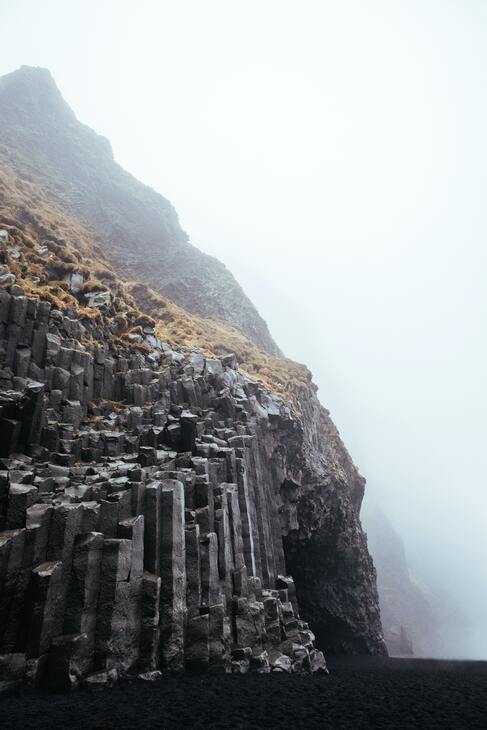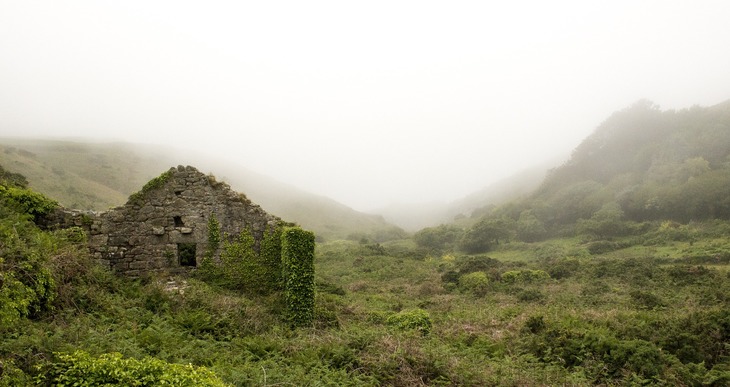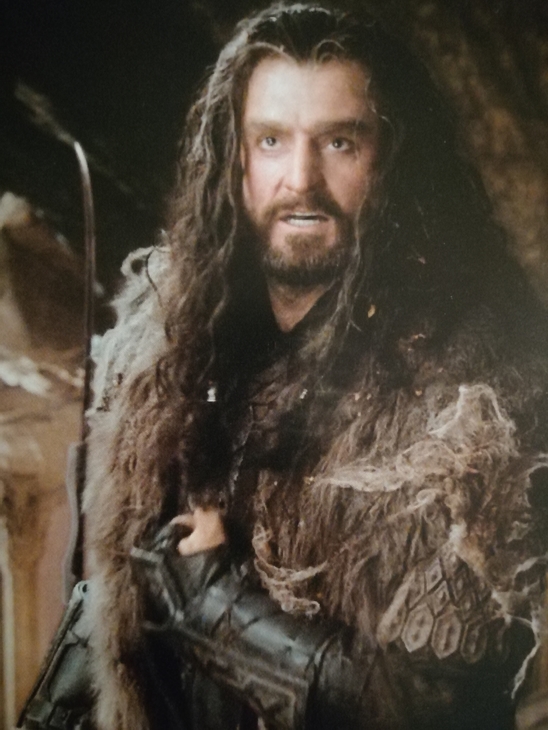While the Dwarves are busy floating around in their barrels, in hopes of outrunning the Orcs, Gandalf is facing an evil that if left untouched will take over Middle-Earth. The quest for Erebor would then be just a dream a company of Dwarves once had. In his capacity as quest instigator Gandalf had fallen short, leaving the Dwarves to their own devices, which have landed them in cells of the Woodland Realm.
As a guardian of Middle-Earth though, Gandalf is instigating his own quest to uncover the evil that hides from the sight of the White Council. Saruman might have discouraged him for a brief moment, but the support of Lady Galadriel and her plea for him to head for the High Fells left him with a clear mission.
Entrance to the tombs
Gandalf’s ascension to the tombs of the High Fells almost had him falling from great heights. It had been a long time since Men of the North took the same path to bury the Witch-King, leaving the path to the tombs everything but accessible. It was imperative not to provide any possibility for anyone to try and venture there. A step that causes Gandalf to lose his balance and almost fall to his death is a direct proof of that.
The iron gate of the tombs had been forcefully opened, leaving Gandalf only to guess what power might have opened them. He enters through the stone doorway immediately losing balance, sliding forward to the end of the hallway.
It must be said that the hallway is interestingly built, for whoever dared to enter was certain to not leave before reaching the tombs, since the hallway slid the person right into the middle of the square-shaped prison, causing them to fall into nothingness without the possibility of ever seeing the light of day again.
Thankfully, Gandalf regains his balance and uses his staff to light his way, exposing the place and discovering that all gates on all tombs have been opened. It could not have been someone mortal strong enough to open them all and simultaneously break the spell releasing its inmates.
Not a nice place to meet
Gandalf: “Oh it’s you.”
Radagast: “Why am I here Gandalf?”
Gandalf: “Trust me, Radagast. I would not have called you here without good reason.”
Radagast: “This is not a nice place to meet.”
Gandalf: “No. It is not.”
As Gandalf enters the tomb of the Witch-King and finds it destroyed, fear and concern cover his face. He nears the tomb thinking he might still find the body inside, but the only thing that pops out of there is a bat, scaring Gandalf. He turns to leave only to face Radagast which startles him again.
Both Wizards find the tombs disturbing and unwelcome. There must be an atmosphere there that fills them with dread and fear. The fact that these are tombs isn’t as scary as knowing who they belonged to.
The Nine
Radagast: “These are dark spells, Gandalf. Old and full of hate. Who’s buried here?”
Gandalf: “If he had a name, it’s long since been lost. He would have been known only as a servant of evil. One of a number. One of nine.”
And there we have it. They are standing in the midst of the tombs of the Ringwraiths, the nine kings of Men to whom Sauron had given the nine rings of power that ultimately corrupted them, twisted them into creatures that are neither alive nor dead, motivated only by the power of the One Ring.
The names of the nine Kings have been lost a long time ago.
The lives they led before the rings ensnared them have been lost to folklore and history leaving them to only be known as the servants of Sauron. However, the rings they were each given referred to their specific powers, as it follows: “Orôm, the Warmonger”, “Sâkhla, the Cruel One”, “Adâsh, the Foe-maker”, “Jûru, the Herald of Mourning”, “Mêbat, the Mirth-eater”, “Khânto, the Pain-giver”, “Sapthân, the Foolstone”, “Nitîr, Terror’s Sting”, “Ûri, the Heart-stopper”. *
Púkel-Men
Radagast: “Why now, Gandalf? I don’t understand.”
Gandalf: “The Ringwraiths have been summoned to Dol Guldur.”
As the two Wizards walk a stone path they pass a stone statue that bears a striking resemblance to the ones found on the winding path of Dunharrow. These stone statues are known as the Púkel-Men, constructed by the Drúedain, whose image they resemble.
The magicians of the Drúedain could give a part of their life energy to these stone statues with their own primitive intelligence that enabled them to act as guardians. The magicians would suffer damage when anyone would attack the statues. When the Drúedain magicians died, the statues would automatically lose the life energy that had supplied them and remain just simple stone statues eroding, with only two black hollow holes for eyes that once sparked red in defiance to the enemies.
The blindness of the Council
Radagast: “But it cannot be the Necromancer. A human sorcerer could not summon such evil.”
Gandalf: “Who said it was human? The Nine only answer to one master. We’ve been blind, Radagast. And in our blindness the Enemy has returned. He is summoning his servants. Azog the Defiler is no ordinary hunter. He is a commander. A commander of legions. The Enemy is preparing for war. It will begin in the East. His mind is set upon that mountain.”
The apparition Radagast saw in Dol Guldur, although it resembled a human silhouette, could not have been one in actuality. No sorcerer dabbling in dark magic could have ever been capable of breaking the spell the Elves have cast over the tombs and release the Nine from their tombs. The only one powerful enough to lift the spell and awake the dead is the same one Saruman declared vanquished and unable to cause any trouble since he cannot take any form without the One Ring.
As it turns out Saruman was wrong, or as discussed in the White Council posts, he could have claimed this only to discourage Gandalf, Galadriel, and Elrond from inquiring further, leaving the evil to grow in power.
Leave the company
Radagast: “Where are you going?”
Gandalf: “To rejoin the others.”
Radagast: “Gandalf.”
Gandalf: “I started this. I cannot forsake them. They are in grave danger.”
Radagast: “If what you say is true, the world is in grave danger. The power in that fortress will only grow stronger.”
Gandalf: “You want me to cast my friends aside?”
Gandalf turns to walk away from Radagast in his efforts to reach the Dwarves in time to warn them about the threat that has risen in Dol Guldur and what its ultimate purpose is. Although far from the company, Gandalf still feels responsible for their fates and their lives. As the instigator of the quest it is a sense of duty that calls to him to rejoin them and keep them from any harm that might befall them.
The bigger picture
Radagast reminds him of the bigger picture, and the danger the whole world is facing. As a guardian of Middle-Earth, one brought there to serve to peace and stability, he has a much bigger responsibility to the rest of the world than to only the 14 of them. There is action to take beyond that of the quest, in which the White Council should also be involved.
To convince the others, organize and ultimately defeat the evil he needs to explore it beyond its obvious surface. He needs to engage it in order to get the full picture of its potency and destructive power. It would be only foolish to head out and face an evil of which he knows little about. For all his powers, Gandalf cannot stand alone against the ancient evil that has risen again.
Although he is aware of all of this, the decision to relinquish his friends falls hard. Guilt and betrayal of his initial purpose claim his heart. He can only imagine how his lack of presence in the company will influence its fate as well. With Thorin as a leader, he can be sure that stubbornness, anger, and prejudice will color the atmosphere of the quest. Hopefully, Bilbo will be able to secure some balance for the group.
Follow me to my next post.
Featured image by Robert Bye on Unsplash
*http://tolkiengateway.net/wiki/Nine_Rings





